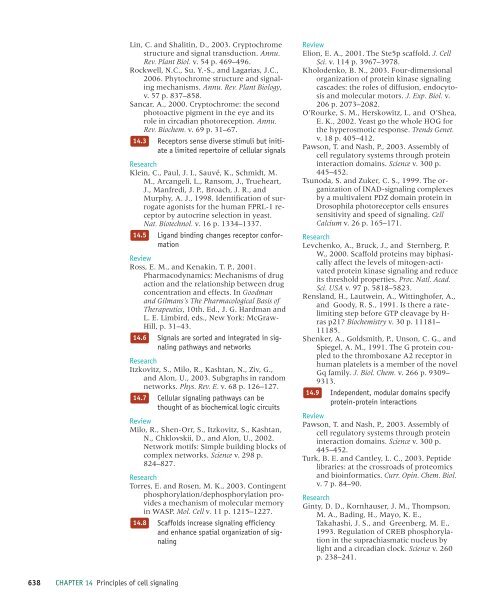Principles of cell signaling - UT Southwestern
Principles of cell signaling - UT Southwestern
Principles of cell signaling - UT Southwestern
You also want an ePaper? Increase the reach of your titles
YUMPU automatically turns print PDFs into web optimized ePapers that Google loves.
39057_ch14_<strong>cell</strong>bio.qxd 8/28/06 5:11 PM Page 638<br />
Lin, C. and Shalitin, D., 2003. Cryptochrome<br />
structure and signal transduction. Annu.<br />
Rev. Plant Biol. v. 54 p. 469–496.<br />
Rockwell, N.C., Su, Y.-S., and Lagarias, J.C.,<br />
2006. Phytochrome structure and <strong>signaling</strong><br />
mechanisms. Annu. Rev. Plant Biology,<br />
v. 57 p. 837–858.<br />
Sancar, A., 2000. Cryptochrome: the second<br />
photoactive pigment in the eye and its<br />
role in circadian photoreception. Annu.<br />
Rev. Biochem. v. 69 p. 31–67.<br />
14.3 Receptors sense diverse stimuli but initiate<br />
a limited repertoire <strong>of</strong> <strong>cell</strong>ular signals<br />
Research<br />
Klein, C., Paul, J. I., Sauvé, K., Schmidt, M.<br />
M., Arcangeli, L., Ransom, J., Trueheart,<br />
J., Manfredi, J. P., Broach, J. R., and<br />
Murphy, A. J., 1998. Identification <strong>of</strong> surrogate<br />
agonists for the human FPRL-1 receptor<br />
by autocrine selection in yeast.<br />
Nat. Biotechnol. v. 16 p. 1334–1337.<br />
14.5 Ligand binding changes receptor conformation<br />
Review<br />
Ross, E. M., and Kenakin, T. P., 2001.<br />
Pharmacodynamics: Mechanisms <strong>of</strong> drug<br />
action and the relationship between drug<br />
concentration and effects. In Goodman<br />
and Gilmans’s The Pharmacological Basis <strong>of</strong><br />
Therapeutics, 10th. Ed., J. G. Hardman and<br />
L. E. Limbird, eds., New York: McGraw-<br />
Hill, p. 31–43.<br />
14.6 Signals are sorted and integrated in <strong>signaling</strong><br />
pathways and networks<br />
Research<br />
Itzkovitz, S., Milo, R., Kashtan, N., Ziv, G.,<br />
and Alon, U., 2003. Subgraphs in random<br />
networks. Phys. Rev. E. v. 68 p. 126–127.<br />
14.7 Cellular <strong>signaling</strong> pathways can be<br />
thought <strong>of</strong> as biochemical logic circuits<br />
Review<br />
Milo, R., Shen-Orr, S., Itzkovitz, S., Kashtan,<br />
N., Chklovskii, D., and Alon, U., 2002.<br />
Network motifs: Simple building blocks <strong>of</strong><br />
complex networks. Science v. 298 p.<br />
824–827.<br />
Research<br />
Torres, E. and Rosen, M. K., 2003. Contingent<br />
phosphorylation/dephosphorylation provides<br />
a mechanism <strong>of</strong> molecular memory<br />
in WASP. Mol. Cell v. 11 p. 1215–1227.<br />
14.8 Scaffolds increase <strong>signaling</strong> efficiency<br />
and enhance spatial organization <strong>of</strong> <strong>signaling</strong><br />
Review<br />
Elion, E. A., 2001. The Ste5p scaffold. J. Cell<br />
Sci. v. 114 p. 3967–3978.<br />
Kholodenko, B. N., 2003. Four-dimensional<br />
organization <strong>of</strong> protein kinase <strong>signaling</strong><br />
cascades: the roles <strong>of</strong> diffusion, endocytosis<br />
and molecular motors. J. Exp. Biol. v.<br />
206 p. 2073–2082.<br />
O’Rourke, S. M., Herskowitz, I., and O’Shea,<br />
E. K., 2002. Yeast go the whole HOG for<br />
the hyperosmotic response. Trends Genet.<br />
v. 18 p. 405–412.<br />
Pawson, T. and Nash, P., 2003. Assembly <strong>of</strong><br />
<strong>cell</strong> regulatory systems through protein<br />
interaction domains. Science v. 300 p.<br />
445–452.<br />
Tsunoda, S. and Zuker, C. S., 1999. The organization<br />
<strong>of</strong> INAD-<strong>signaling</strong> complexes<br />
by a multivalent PDZ domain protein in<br />
Drosophila photoreceptor <strong>cell</strong>s ensures<br />
sensitivity and speed <strong>of</strong> <strong>signaling</strong>. Cell<br />
Calcium v. 26 p. 165–171.<br />
Research<br />
Levchenko, A., Bruck, J., and Sternberg, P.<br />
W., 2000. Scaffold proteins may biphasically<br />
affect the levels <strong>of</strong> mitogen-activated<br />
protein kinase <strong>signaling</strong> and reduce<br />
its threshold properties. Proc. Natl. Acad.<br />
Sci. USA v. 97 p. 5818–5823.<br />
Rensland, H., Lautwein, A., Wittingh<strong>of</strong>er, A.,<br />
and Goody, R. S., 1991. Is there a ratelimiting<br />
step before GTP cleavage by H-<br />
ras p21? Biochemistry v. 30 p. 11181–<br />
11185.<br />
Shenker, A., Goldsmith, P., Unson, C. G., and<br />
Spiegel, A. M., 1991. The G protein coupled<br />
to the thromboxane A2 receptor in<br />
human platelets is a member <strong>of</strong> the novel<br />
Gq family. J. Biol. Chem. v. 266 p. 9309–<br />
9313.<br />
14.9 Independent, modular domains specify<br />
protein-protein interactions<br />
Review<br />
Pawson, T. and Nash, P., 2003. Assembly <strong>of</strong><br />
<strong>cell</strong> regulatory systems through protein<br />
interaction domains. Science v. 300 p.<br />
445–452.<br />
Turk, B. E. and Cantley, L. C., 2003. Peptide<br />
libraries: at the crossroads <strong>of</strong> proteomics<br />
and bioinformatics. Curr. Opin. Chem. Biol.<br />
v. 7 p. 84–90.<br />
Research<br />
Ginty, D. D., Kornhauser, J. M., Thompson,<br />
M. A., Bading, H., Mayo, K. E.,<br />
Takahashi, J. S., and Greenberg, M. E.,<br />
1993. Regulation <strong>of</strong> CREB phosphorylation<br />
in the suprachiasmatic nucleus by<br />
light and a circadian clock. Science v. 260<br />
p. 238–241.<br />
638 CHAPTER 14 <strong>Principles</strong> <strong>of</strong> <strong>cell</strong> <strong>signaling</strong>
















